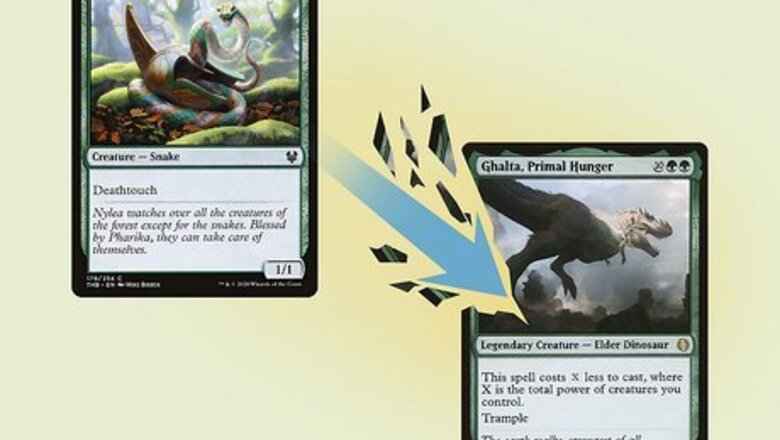
views
What is deathtouch?
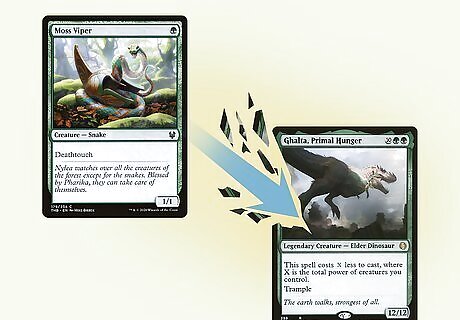
Deathtouch is a static ability that changes how damage works. Normally, a creature only destroys another creature in combat if its power is high enough to match another creature’s toughness. For example, a 2/2 will die to a 3/3 because 2 toughness is lower than 3 power. Deathtouch changes that. This keyword states, “Any amount of damage this deals to a creature is enough to destroy it.” In other words, a 1/1 with deathtouch will kill a 5/5 in combat! Deathtouch is a static ability, as opposed to a triggered ability. This means that deathtouch doesn’t use the stack—it’s just something that’s true at all times. Alongside flying, defender, flash, first strike, and haste, deathtouch is one of the most common keywords in the game. It appears in basically every set and will come up in a huge percentage of games. Deathtouch only affects combat with creatures. It has zero impact on player damage or planeswalkers. Deathtouch is primarily a green and black keyword. In terms of flavor, it’s supposed to emulate poisonous and venomous creatures. That’s why it often appears on cards named things like Acidic Slime and Elderfang Venom.
Does deathtouch work when blocking?

Yes, deathtouch doesn’t care if you’re attacking or blocking. Any damage a creature with deathtouch assigns in combat works the exact same way. So, if you have a 2/2 with deathtouch who attacks and gets blocked by a 4/5, both creatures die. If you were to block that 4/5 with your 2/2, the same outcome would occur. Blocking is actually what makes deathtouch so powerful. If you have a creature with deathtouch on the board, it makes attacking very difficult for your opponent. They basically have to throw away their best creature to get rid of your deathtouch blocker if they’re going to force damage through!
How does deathtouch work with multiple blockers?

Multiple blockers fare poorly against deathtouch. In the official rules, it states, “Any nonzero amount of combat damage assigned to a creature by a source with deathtouch is considered to be lethal damage…” This is a fancy way of saying that a creature with deathtouch only needs to deal 1 damage to a creature for it to be lethal. You only have to assign lethal damage to a blocker, though. As a result, a 4/4 with deathtouch will kill four 5/5s if they all block it! Remember, if you’re blocking a creature with deathtouch, it’s better to use a single large blocker than multiple smaller blockers. This is one of the most important and counterintuitive interactions with deathtouch. Players will often forget about how this works, so you can often get some big momentum changes by remembering how this works.
How does deathtouch work with first strike?
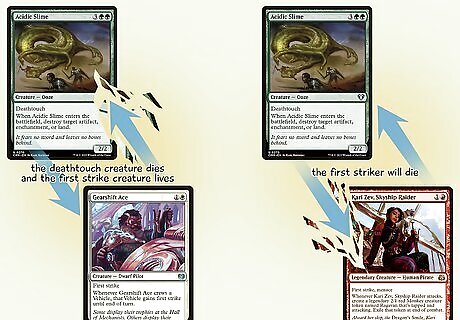
First strike damage occurs before deathtouch matters. Per the reminder text, a creature with first strike “deals combat damage before creatures without first strike.” So, first strike creatures always deal damage before regular creatures—even if they have deathtouch. As a result, deathtouch creatures have to wait for first strike creatures to finish assigning damage before they can assign damage back. If a 2/2 with deathtouch fights a 2/1 with first strike, the deathtouch creature dies and the first strike creature lives. However. If a 2/2 deathtouch creature fights a 1/3 with first strike, the first striker will die. It deals the 1 damage, which isn’t enough to kill the 2/2, and then the 2/2 hits the 1/3. This wouldn’t normally be enough damage to kill it, but with deathtouch it is.

Deathtouch creatures with first strike are hard to stop. A creature with first strike and deathtouch is basically unstoppable unless they’re blocked by more creatures than the deathtouch attacker’s power (i.e. if the attacker is a 5/5, you need at least 6 blockers). The first striker gets to attack first, and deathtouch assigns only 1 damage to each blocker, so it takes a lot of creatures to deal with something like this. There are very few notable creatures with deathtouch and first strike—it’s just such a powerful combo that they don’t print very many of them. However, Master of Cruelties, Glissa, the Traitor, and Glissa, Herald of Predation are all popular EDH cards. The two Glissa cards in particular are very popular commanders to build around if you like green/black.
How does deathtouch work with trample?
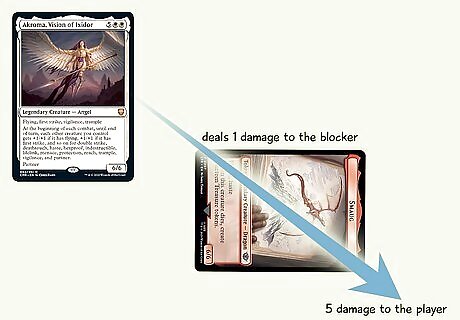
Deathtouch amplifies the power of trample. This is one of the more frustrating rule interactions if you’re trying to block. A creature with deathtouch and trample will deal 1 damage to each blocker. Then, the remaining damage spills over to the player. So, a 4/4 with deathtouch and trample being blocked by a 4/4 will deal 1 damage to the blocker, and 3 damage to the player. You can end a lot of tight games with the combination of deathtouch and trample. Trample is irrelevant if the creature is blocking.
How does deathtouch work with indestructible?

Deathtouch cannot take down creatures with indestructible. Indestructible specifically states, “Damage and effects that say ‘destroy’ don’t destroy this.” Deathtouch specifically says, “Any amount of damage this deals to a creature is enough to destroy it.” That “destroy” word is important. Deathtouch destroys, and cards with indestructible can’t be destroyed. As a result, the indestructible creature survives combat with a creature that has deathtouch. There are no cards with both indestructible and deathtouch. You can give a creature those abilities with Gift of Doom or Battle-Rage Blessing, though!
Does deathtouch kill planeswalkers and players?

No, deathtouch is only relevant to creatures. When a creature with deathtouch hits a player or planeswalker, it assigns damage like any other boring old creature. Deathtouch is only important when it comes to how creatures deal damage to other creatures. So, let’s say you’ve got a 6/3 with deathtouch and you attack a Karn Liberated with 10 loyalty points. After damage, the Karn will still be on the board with 4 loyalty.
Handling Your Opponent’s Deathtouch Creatures
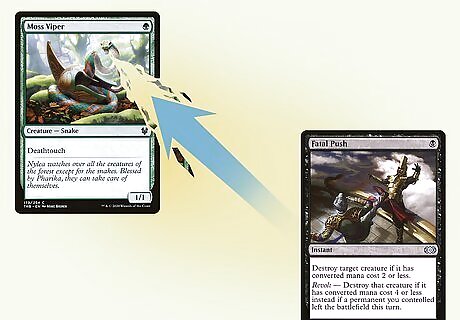
Remove the creature causing you trouble. Creatures with deathtouch are great targets for counters like Counterspell and Essence Scatter. They have so much value on the board that most control players are happy to spend the counter magic on them. If you don’t run counterspells, removal is your best bet. Cards like Murder, Journey to Nowhere, and Fatal Push can remove most deathtouch creatures with no problem. With that said, there’s nothing wrong with throwing away the best creature on the board by attacking into a creature with deathtouch if momentum is still on your side.
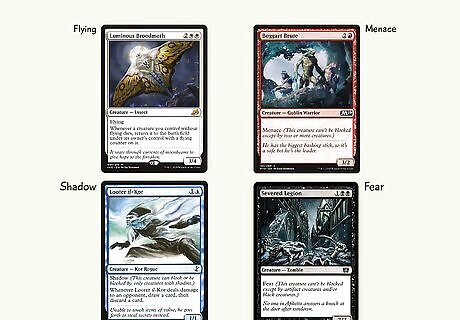
Go around the creature and ignore it. Creatures with flying, menace, shadow, and fear will normally be able to completely ignore a creature with deathtouch. These evasion abilities are just too hard to block for the average deathtouch card. Remember—you win a game of Magic: the Gathering by dealing 20 damage to an opponent—not by removing all of their creatures! A lot of constructed decks don’t even play creatures, and that’s where deathtouch really shines.
Powerful Deathtouch Cards and Synergies

Throw Basilisk Collar on a Walking Ballista to build a machine gun. Basilisk Collar gives creatures deathtouch. Walking Ballista can deal damage to any target. See the combo here? You can deal one damage (called “pinging”) to any creature on the board to kill it instantly! This is popularly known as the “machine gun” combo. If you can get a Heliod, Sun-Crowned on the board, you can turn Walking Ballista into an infinite source of damage!
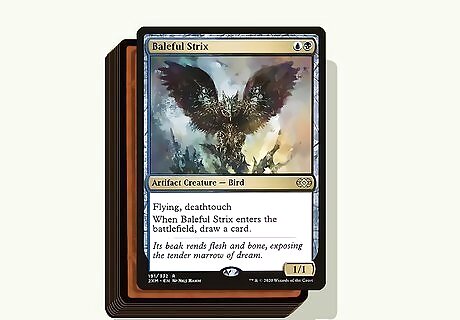
Throw Baleful Strix into any blue-black deck to improve it. Baleful Strix is one of the most-played cards of all-time. For just one blue and one black mana, you get a 1/1 with deathtouch and flying. That’s already pretty incredible, since it can block basically anything. But the cherry on top? It draws a card. That means it even replaces yourself in your hand, which is ridiculous value for 2 mana. There’s a joke in MTG that the 3 most powerful words in the game are “draw a card.” Cards that draw other cards give you a big advantage, help you find your key cards, and prevent you from running out of things to do.
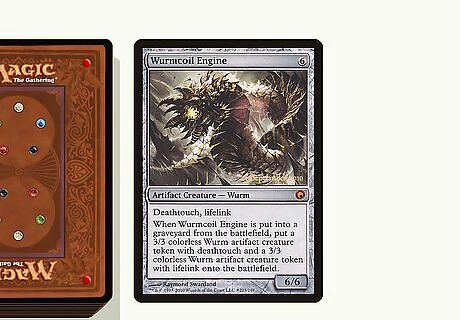
Consider Wurmcoil Engine as a colorless deathtouch option. Deathtouch is basically exclusive to green and black creatures. It appears on a few other cards in other colors, but those cards tend to be pretty terrible. The big exception is Wurmcoil Engine, which is colorless. If you want a deathtouch creature that packs a punch, Wurmcoil Engine can go in any deck! Cards like Wurmcoil Engine really shine in environments where players are casting a ton of creatures. It’s not the best threat in a combo-heavy environment, though.



















Comments
0 comment